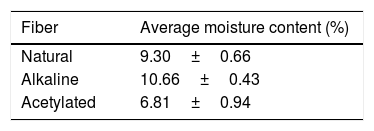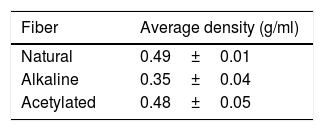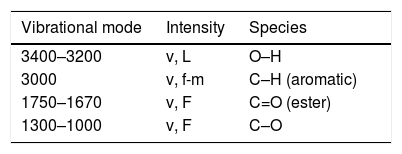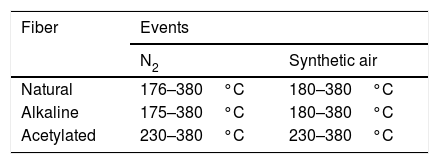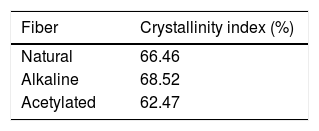The bamboo fiber has been studied as composite reinforcement for offering lightness and more resistance to the material. Alkalization and acetylation are superficial chemical treatments based on alkaline solution and on a solution based in acid and acetic anhydride, respectively, which modify the fibers composition, introducing functional groups acetyl, turning it hydrophobic. In this project, it was aimed the application of the alkalinization and acetylation treatments, attempting to improve the fibers adhesion to the polymers when in a composite. The fibers were evaluated by moisture content, water absorption tests by immersion, density, infrared spectroscopy, thermogravimetric analysis, X-ray diffraction, tensile tests, and morphological analysis. When acetylated, the bamboo fiber presented lower water absorption (62.98%), gained thermal stability of approximately 50°C, presented lower crystallinity (62.47%) and, according to SEM images, the fibers has shown an increase of surface roughness, facts that contribute to the best fiber/matrix adhesion in composites. The acetylation decreased the mechanical strength of the fiber, supporting 19,820MPa, against 27,670MPa from the natural and 31,730MPa from the alkaline.
With the constant search for low-cost, environmental friendly materials that have good physical, mechanical and thermal properties, researchers have been exploring the possibility of utilizing natural fibers as reinforcements for composite materials in civil construction, aeronautical, automobile, and other industries.
The natural fibers most commonly used as reinforcement are the coconut, sisal, juta, and sugar cane fibers, already explored in the Brazilian literature [1]. However, there was a growing interest in studying the bamboo fiber, since it grows quickly, and as such, can renew faster (it takes up to 3 or 4 years to reach the adulthood). Additionally, it has higher hardness and resistance, as well as lower density, which are important characteristics to produce a good composite material [2–5].
The bamboo is a plant that belongs to Gramineae family, mostly found and used in Asia, where the largest producers are China and India, being also found in Africa and the American continent. With about 115 genres of bamboo around the world, more than 1500 species are used in diverse applications, from the creation of popular houses in countries like Ecuador and Colombia, to great civil works like bridges and temples in Japan, China, and India [3,5–7].
The bamboos consist essentially of an underground rhizome and hollow woody culms with fibers arranged in the form of bundles, mainly in the outermost region endowed with branches and leaves. Morphologically, the bamboo consists of parenchymal tissue, vessels, and fibers [8–10]. First introduced during the time of the first Portuguese immigrants, the most abundant species in Brazil is the Bambusa vulgaris, and in Brazil, there is an area of more than 30,000ha of bamboo which form dense clumps with approximately 15m in height, stemming from 5 to 10cm in diameter with internodes from 24 to 40cm in length [6].
Chemically, the bamboo is similar to wood and it is characterized by its relatively high content of lignin, cellulose, and hemicellulose, which represent more than 90% of the total bamboo mass [3,5,11,12].
Adhikari et al. [13] investigated the possibility of developing low-cost towers of bamboo to shorten wind turbines, analyzing the characteristics of the bamboo and utilizing a tower of bamboo 12m high for a wind turbine of 500W, making analysis via analytical methods and of finite elements, resulting in a promising potential of reducing costs for smaller wind turbine towers in developed countries.
Francisco [14] utilized bamboo sticks to build barriers of containment for soil erosion, waterproofing bamboo with the use of polypropylene raffia, decreasing the cost and increasing the durability of the barrier.
Some papers have been published on the study of bamboo fiber reinforced composites. Yosoffa et al. [15] developed composites materials using bamboo fiber as reinforcement, obtaining good mechanical properties. Costa et al. [16] used bamboo fibers for the manufacture of polymer matrix laminates, where the laminates presented good mechanical tensile properties, resulting in a material of low cost and low environmental impact. Melo [17] used bamboo fibers as reinforcement in virgin and recycled polypropylene matrix, developing a new material with good properties, reusing polymeric residues.
This work is a part of a study about development of polymeric composite materials, where the natural and treated bamboo fibers were used to reinforcing polyester resin matrix. This way, the bamboo fibers were modified and some characterization was performed in order to compare the mechanical properties of these fibers.
2Materials and methodsThe bamboo used was from B. vulgaris species, which is found in northeastern Brazil, in the State of Ceará, in the city of Fortaleza. The fibers were taken from an adult bamboo, with dry sticks, aged 6 or 7 years. The internodes were separated with the aid of a saw and fibers were withdrawn manually with the aid of a cutting tool. No immunization methods were used.
First, the fiber samples were washed in water at 50±2°C using the vertical autoclave, and then washed with deionized water at room temperature. Afterwards, the fibers were taken to the drying oven, where they remained for 24h at 60±2°C, after which they were stored in a desiccator.
After that, the fibers were immersed for 1h in 1% aqueous sodium hydroxide solution (NaOH) under gentle agitation. After this period, the fibers were washed initially in tap water and then in deionized water until the pH of the wash water was equal to the pH of the deionized water used. The fibers were then returned to the drying oven at 60±2°C for 24h and were taken to the desiccator to cool down for further application of the acetylation treatments.
The acetylation process was performed based on the methodology described by the authors Lopes et al. [18], D’Almeida [19], Lopes et al. [20], in which the use of catalyst is dispensed. To acetylation, the alkaline fiber samples were conditioned in a condensation reactor, under agitation and a thermostatic bath with acetic anhydride solution and acetic acid, in the proportion of 1.5:1.0. The reaction time (contact between fibers and solution) was 1 hour, and the reaction temperature was 100±2°C. After the reaction time, the samples were washed in tap water and then in deionized water to remove the reagents. The fibers were washed until the pH of the bath water was the same as that of the deionized water. The fibers were then placed into the oven to 60°C for 24h for drying, being afterward cooled and stored in a desiccator until the time of the tests.
In order to measure the area of these fibers, a vertical profile projector of brand Mitutoyo model PJ-3000 was used, provided by the Serviço Nacional de Aprendizagem Industrial in Center of Excellence in Technology and Innovation (SENAI – CETIS), located in the municipality of Maracanaú. The area of the bamboo fibers was measured using population statistics analysis, where 30 fibers were used to define the mean average area of the natural, alkaline, and acetylated fibers. The corresponding data were used to analyze the mechanical properties of each type of fiber.
The test of moisture content of bamboo fibers was carried out according to the method described in the Brazilian Pharmacopeia (2010), which is based on the loss of water mass by drying in an oven, carried out in triplicate.
For the water absorption test, approximately 1g of each type of fiber was weighted in an analytical balance, and immersed in a beaker with deionized water. After 24h, the fibers were then removed from the water, dried on surface with the aid of paper towels, weighed again and, according to the formula below, the percentage of water absorption of each fiber was measured. Five analyses were performed for each type of bamboo fiber.
where, Wa – water absorption (%), P1 – final weight after 24h immersed in deionized water (g), P0 – dry fiber initial weight (g).For the natural, alkaline and acetylated fiber density test, ASTM D792, method A, was used in triplicate.
The infrared spectroscopy test (FTIR) was performed at the Universidade Federal do Ceará, in the department of chemistry, in Shimadzu brand equipment IRTrace-100 model, realized in KBr pellets in the wavelength range of 400–4000cm−1, aiming to analyze the chemical composition of the fibers before and after the treatments.
The thermogravimetry (TG) test was also carried out at the Universidade Federal do Ceará, in the Thermal Tests laboratory, using a TA instruments TGA50-Q Series model equipment. The methods were Nitrogen and Synthetic Air atmosphere, with a flow of 50mL per minute (for both analysis, inert and oxidative), in a temperature range of 25–900°C, with heating rate of 10°C per minute in a platinum cell and mass round 10mg.
The X-ray diffraction test was carried out at the Federal University of Ceará, at the Materials Characterization Laboratory of the Department of Metallurgical Engineering, in a Philips brand diffractometer and model X’Pert, with 40kV in cobalt tube, with a scale of peaks between 10° and 40°.
For the fiber tensile test, a universal mechanical test machine from the SENAI Chemical Laboratory, EMIC model DL2000 was used to test specimens for 30 fibers of each type in accordance with ASTM C1557-14. The software used for calculations of tensile tests was the TESC.
The morphological characterization of the fibers was performed by scanning electron microscopy (SEM) in Quanta 540 FEG – FEI equipment, from the Analytical Center of the Department of Physics of the Federal University of Ceará, with an acceleration voltage of 20kV and different magnifications. The samples were fixed in a sample door (stub) with carbon tape and metalized with gold for conduction of electrons and to avoid accumulation of charges and consequent destruction of the samples, in the metallizer QT150 ES – Quorum.
3Results and discussionIt was found that the population mean area of the natural fibers was superior to the other elaborated fibers. The cross-sectional area of the alkaline fiber was lower than that found for acetylated fiber, a fact justified by the loss of surface material by the extraction of extractable groups (low molecular weight lignin, greases, oils, fats). As for the acetylated fiber, there was an increase of section area, raising the hypothesis of a fiber swelling. Such swelling may be due to the insertion of acetyl groups which contributed simultaneously to the increase in diameter and to the loss of hydrogen interactions that aid in fiber compaction. The mean population areas of the different fiber types are described in Table 1.
The moisture content test showed that the acetylated fiber is the one that less absorbs moisture in the air, a fact explained by the increased hydrophobicity of the fiber by the insertion of acetyl groups on the hydroxyls. The bamboo alkaline fiber, due to the higher hydroxyl content, presented the higher moisture content, because the free hydroxyls on the surface of the fiber facilitate the occurrence of hydrogen bonds. Table 2 shows the result of the moisture content of the fibers.
About the water absorption, presented in Table 3, we can conclude that all fibers absorbed water:alkaline fiber being the most absorbent (143.70%) due to the increase of hydroxyls groups because of the treatment realized in NaOH. The acetylated fiber was the one that absorbed the least amount of water (62.98%), which can be explained by the successful acetylation process, wherein the fiber became less hygroscopic due to hydroxyls substitution for acetyl groups.
With the alkalinization process, in which the fiber lost part of the waxes, low molecular weight lignins and oils, the average fiber density decreased relative to natural fiber. After acetylation, in which the fiber received acetyl groups, the mean fiber density increased in relation to the alkaline fiber as shown in Table 4.
According to the spectra obtained (Fig. 1), for being a superficial reaction, a wide stretching (v, L) of the fibers was observed after the treatments performed through peaks, in which the peak referring to hydroxyl (O–H), between 3400 and 3200cm−1 was similar in three samples, suffering little influence with the acetylation process [3,12,18].
There were variations of the stretch (between low and middle) in the peak found in 3000cm−1, referring to C–H couplings. The strong stretch (v, L) in the wavelength between 1750 and 1670cm−1 of the acetylated fiber indicates the emergence of the carbonyl group (C=O), indicator that the acetylation was occurred with success [3,12,21].
The peak localized in the range of 1300 and 1000cm−1 is related to strong stretches of the couplings C–O, being more accentuated in the acetylated fiber [3,12,21]. Table 5 shows the species found in the FTIR.
It can be noted that all samples showed mass loss with the increase of the temperature between 25 and 105°C, due to the loss of moisture (Figs. 2 and 3).
In an atmosphere of N2, the natural bamboo shows an well-pronounced event, which goes from approximately 176°C to 380°C, characteristic of thermal degradation of lignin and cellulose. At the beginning of this pronounced event, there is a small event that can be attributed to degradation of the natural extracts of bamboo fiber associated with degradation of the hemicellulose segments [12,21–23].
The sample of alkalized bamboo did not present a significant change in the region where occurs the maximum of the degradation, occurring in 316°C. The alkalized bamboo fiber had one degradation band ranging from 175°C to 380°C, showing the same region found for degradation of the natural fiber [12,21–23].
The sample of acetylated bamboo presented an improvement in the thermal stability in N2 atmosphere, being degradation initiated at approximately 230°C and going up to 380°C. Such an increase in the degradation temperature of the acetylated fiber is related to the binding energy required to degrade the acetyl group, which has been inserted with the treatment, giving a higher thermal stability to the fiber as compared to the alkaline fiber. The alkaline fiber has free hydroxyls, which require a lower amount of energy to degrade [12,21–23].
Pereira [24] reported that, even in an oxidative atmosphere, the results show a similarity in the degradation behavior of hemicellulose, lignin and cellulose. Fig. 3 shows the events found in degradation in synthetic air.
The evaluation of thermogravimetry in a synthetic air atmosphere also revealed a gain of the thermal stability when compared the acetylated with alkaline and the natural bamboo fibers, having risen by 50°C the temperature of the thermal degradation. This result becomes very important for applications in polymeric composite materials, given that in many cases, the temperature of process is superior to 200°C. Table 6 shows the degradation events found.
Fig. 4 shows the graphs obtained in the X-ray diffraction analysis.
As shown in Table 7, the fiber crystallinity index was in the order alkaline>natural>acetylated. This fact can be justified by the removal of waxes, oils and greases through the alkaline treatment, reducing the amorphous content of the fiber, consequently increasing its crystallinity. With the treatment of acetylation, the fiber loses its free hydroxyls, reducing the content of hydroxyl responsible for the hydrogen bonds, resulting in the decrease of the crystallinity of the fiber.
According to the tensile test carried out, we can conclude that the mechanical properties were affected after the treatments suffered by the fibers, as shows Table 8.
Mechanical properties of the natural, alkaline and acetylated fibers.
| Fiber | Average tensile in the maximum force (MPa) | Average deformation of the maximum force (%) | Average modulus of Elasticity (MPa) |
|---|---|---|---|
| Natural | 276.70±70.06 | 17.46±7.51 | 2260±1148 |
| Alkaline | 317.30±49.79 | 10.17±2.48 | 3497±337 |
| Acetylated | 198.20±30.56 | 8.41±1.44 | 2555±237 |
As previously seen in Table 1, the alkaline fiber has a smaller area than the natural fiber, which shows that despite the reduction of its area, the alkaline fiber showed a superior mechanical performance regarding the results of tensile in the maximum force. There was a decrease of the deformation of the maximum force when compared to the advance of chemical treatments, being greater in the natural fiber and lower in the acetylated [17].
The smaller mechanical performance was found in acetylated bamboo fiber. It was verified according to Table 1 that the area of the acetylated bamboo fiber had an increase when compared to alkaline, a fact that did not contribute to the improvement in the mechanical properties, being its tension in the maximum force and deformation in the maximum force inferior [18].
This behavior can be explained by the chemical treatments that were utilized, since with acetylation, the hydroxyls of the cellulose segments, hemicellulose, and lignin react, forming acetyl groups due to the reaction with the acetic anhydride. This causes some loss of the intermolecular interactions of the constituent macromolecules of the lignocellulosic arrangement, leading to a reduction of the maximum force and average maximum deformation [25].
Through the graphs of performance of the fibers, as shown in Fig. 5, the fragile behavior of the fibers can be noted.
Through the fibers morphological analysis it was possible noted in roughness increase of the fibers, being more pronounced in the acetylated fiber due the removal of waxes and oiliness that fill the vacancies and imperfections of the fiber, increasing its adhesiveness when used as reinforcement in composite materials. Fig. 6 shows the increase in roughness in the treated fibers.
4ConclusionsDue to the treatments performed, we could perceive a reduction in the diameter of the treated fibers, as well as the density of the fibers.
According to the FTIR analysis performed, we confirmed that the treatment of acetylation occurred successfully, reducing the hydrophilicity of bamboo fibers, confirmed by the water absorption test and moisture content.
The infrared test revealed the changes suffered in fiber composition according to the treatment wherein, due to increasing of the peak located in the range of 1300–1000cm−1, which show that the acetylation had occurred with success.
The acetylation process gave more thermal stability to bamboo fibers due to higher binding energy to degrade the acetyl group. According to the thermogravimetry test in synthetic air atmosphere and N2, the initial degradation temperature increased in 50°C in comparison to the natural and alkalinized bamboo fibers.
Also, according to the tensile test realized, it was possible to verify the reduction of the mechanical properties of the acetylated fibers in relation to natural and alkaline fibers. It is possible to verify that the tensile strength of acetylated fibers decreased 28.3% in comparison with natural bamboo fiber. In the other hand, the tensile strength of alkalinized bamboo was 12.8% higher than the natural fiber.
Results related to crystallinity found by X-ray diffraction show that the crystallinity of alkaline fiber was higher than that found in natural fiber and in acetylated fibers, in that order.
This fact has a direct correlation with the results obtained for the tensile test in the fibers, being the higher flow voltage for the alkaline fiber, followed by the natural and acetylated fibers, fact that shows that the higher the crystallinity, the higher the yield stress.
For morphological analysis, after treatment, the bamboo fibers had a higher surface roughness, improving adhesion of the matrix fiber when used as reinforcement in composite materials.
The authors are grateful for Fundação Cearense de Apoio ao Desenvolvimento Científico e Tecnológico – FUNCAP, Serviço Nacional de Aprendizagem Industrial – SENAI, Laboratório de Mecânica da Fratura e Fadiga – LAMEFF and Universidade Federal do Ceará – UFC.











